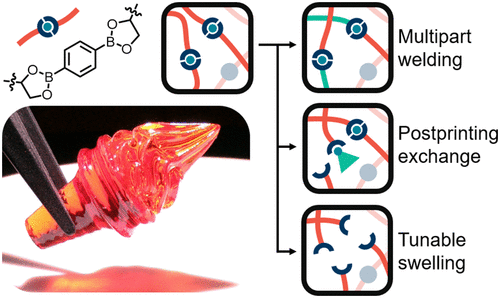当前位置:
X-MOL 学术
›
ACS Macro Lett.
›
论文详情
Our official English website, www.x-mol.net, welcomes your
feedback! (Note: you will need to create a separate account there.)
Chemical and Mechanical Tunability of 3D-Printed Dynamic Covalent Networks Based on Boronate Esters
ACS Macro Letters ( IF 5.1 ) Pub Date : 2021-06-23 , DOI: 10.1021/acsmacrolett.1c00257 Lindsay L. Robinson , Jeffrey L. Self , Alexander D. Fusi , Morgan W. Bates , Javier Read de Alaniz , Craig J. Hawker , Christopher M. Bates , Caitlin S. Sample
ACS Macro Letters ( IF 5.1 ) Pub Date : 2021-06-23 , DOI: 10.1021/acsmacrolett.1c00257 Lindsay L. Robinson , Jeffrey L. Self , Alexander D. Fusi , Morgan W. Bates , Javier Read de Alaniz , Craig J. Hawker , Christopher M. Bates , Caitlin S. Sample

|
As the scope of additive manufacturing broadens, interest has developed in 3D-printed objects that are derived from recyclable resins with chemical and mechanical tunability. Dynamic covalent bonds have the potential to not only increase the sustainability of 3D-printed objects, but also serve as reactive sites for postprinting derivatization. In this study, we use boronate esters as a key building block for the development of catalyst-free, 3D-printing resins with the ability to undergo room-temperature exchange at the cross-linking sites. The orthogonality of boronate esters is exploited in fast-curing, oxygen-tolerant thiol–ene resins in which the dynamic character of 3D-printed objects can be modulated by the addition of a static, covalent cross-linker with no room-temperature bond exchange. This allows the mechanical properties of printed parts to be varied between those of a traditional thermoset and a vitrimer. Objects printed with a hybrid dynamic/static resin exhibit a balance of structural stability (residual stress = 18%) and rapid exchange (characteristic relaxation time = 7 s), allowing for interfacial welding and postprinting functionalization. Modulation of the cross-linking density postprinting is enabled by selective hydrolysis of the boronate esters to generate networks with swelling capacities tunable from 1.3 to 3.3.
中文翻译:

基于硼酸酯的 3D 打印动态共价网络的化学和机械可调性
随着增材制造范围的扩大,人们对源自具有化学和机械可调性的可回收树脂的 3D 打印物体产生了兴趣。动态共价键不仅可以提高 3D 打印物体的可持续性,还可以作为打印后衍生的反应位点。在这项研究中,我们使用硼酸酯作为开发无催化剂 3D 打印树脂的关键组成部分,该树脂能够在交联位点进行室温交换。硼酸酯的正交性被用于快速固化、耐氧的硫醇-烯树脂,其中可以通过添加静态共价交联剂来调节 3D 打印物体的动态特性,而无需室温键交换. 这允许打印部件的机械性能在传统热固性和玻璃体之间变化。用混合动态/静态树脂打印的物体表现出结构稳定性(残余应力 = 18%)和快速交换(特征松弛时间 = 7 秒)的平衡,允许界面焊接和打印后功能化。通过硼酸酯的选择性水解来调节印刷后的交联密度,以产生溶胀能力可在 1.3 至 3.3 之间调节的网络。允许界面焊接和印后功能化。通过硼酸酯的选择性水解来调节印刷后的交联密度,从而产生溶胀能力可从 1.3 调整到 3.3 的网络。允许界面焊接和印后功能化。通过硼酸酯的选择性水解来调节印刷后的交联密度,以产生溶胀能力可在 1.3 至 3.3 之间调节的网络。
更新日期:2021-07-20
中文翻译:

基于硼酸酯的 3D 打印动态共价网络的化学和机械可调性
随着增材制造范围的扩大,人们对源自具有化学和机械可调性的可回收树脂的 3D 打印物体产生了兴趣。动态共价键不仅可以提高 3D 打印物体的可持续性,还可以作为打印后衍生的反应位点。在这项研究中,我们使用硼酸酯作为开发无催化剂 3D 打印树脂的关键组成部分,该树脂能够在交联位点进行室温交换。硼酸酯的正交性被用于快速固化、耐氧的硫醇-烯树脂,其中可以通过添加静态共价交联剂来调节 3D 打印物体的动态特性,而无需室温键交换. 这允许打印部件的机械性能在传统热固性和玻璃体之间变化。用混合动态/静态树脂打印的物体表现出结构稳定性(残余应力 = 18%)和快速交换(特征松弛时间 = 7 秒)的平衡,允许界面焊接和打印后功能化。通过硼酸酯的选择性水解来调节印刷后的交联密度,以产生溶胀能力可在 1.3 至 3.3 之间调节的网络。允许界面焊接和印后功能化。通过硼酸酯的选择性水解来调节印刷后的交联密度,从而产生溶胀能力可从 1.3 调整到 3.3 的网络。允许界面焊接和印后功能化。通过硼酸酯的选择性水解来调节印刷后的交联密度,以产生溶胀能力可在 1.3 至 3.3 之间调节的网络。











































 京公网安备 11010802027423号
京公网安备 11010802027423号